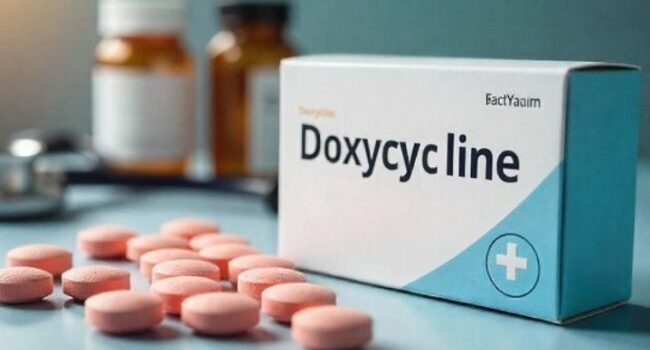 Health
Health
How Doxycycline Treats Acne and Skin Conditions Effectively
Doxycycline 100 mg buy online is widely recognized as one of the most effective oral antibiotics for treating moderate to severe acne and various inflammatory skin conditions. Originally developed as a broad-spectrum antibiotic, doxycycline has found a significant role in dermatology due to its dual action: antibacterial and anti-inflammatory. Over the years, it has become a cornerstone therapy for individuals struggling with persistent acne, rosacea, and other skin-related disorders.
In this article, we will explore how doxycycline works, why it is effective for skin conditions, how it is used in treatment, its benefits, possible side effects, and tips for safe usage.
Understanding Acne and Inflammatory Skin Conditions
Before discussing how doxycycline treats acne, it’s important to understand the root causes of acne and other skin issues.
Acne is a complex skin condition often triggered by several factors, including:
-
Overproduction of sebum (skin oil)
-
Clogged hair follicles
-
Bacterial overgrowth, particularly Cutibacterium acnes (formerly Propionibacterium acnes)
-
Inflammation
In addition to acne, conditions like rosacea (a chronic skin condition causing redness and pimples), perioral dermatitis, and hidradenitis suppurativa also involve bacterial imbalances and inflammatory responses, making them responsive to treatments like doxycycline.
How Doxycycline Works for Acne and Skin Conditions
Doxycycline helps treat skin issues through two primary mechanisms:
1. Antibacterial Action
Doxycycline belongs to the tetracycline class of antibiotics. It targets and inhibits protein synthesis in bacteria by binding to the 30S ribosomal subunit. This halts bacterial growth and prevents further colonization, especially in hair follicles and sebaceous (oil) glands.
In acne, Cutibacterium acnes bacteria contribute to inflammation and the formation of pustules and nodules. Doxycycline reduces the number of these bacteria, helping clear active breakouts.
2. Anti-Inflammatory Effects
Beyond killing bacteria, doxycycline has a potent anti-inflammatory effect that helps reduce the redness, swelling, and discomfort associated with acne and other skin conditions. It inhibits the production of inflammatory cytokines, enzymes like matrix metalloproteinases (MMPs), and reactive oxygen species, which play a key role in acne-related inflammation.
This dual-action—reducing bacteria and inflammation—makes doxycycline uniquely effective, even in cases where bacteria are not the primary problem (e.g., rosacea).
Common Skin Conditions Treated With Doxycycline
1. Moderate to Severe Acne Vulgaris
Doxycycline is especially effective in treating inflammatory acne, which includes papules, pustules, nodules, and cysts. It is usually prescribed when topical treatments alone are not sufficient.
2. Rosacea
In rosacea, doxycycline is used at sub-antimicrobial doses (like 40 mg daily) to control inflammation without contributing to antibiotic resistance. It helps reduce redness, flushing, and acne-like breakouts.
3. Perioral Dermatitis
This condition, characterized by red bumps and irritation around the mouth and nose, responds well to doxycycline due to its anti-inflammatory properties.
4. Hidradenitis Suppurativa
A chronic, painful condition that causes inflamed nodules and abscesses in areas like the armpits and groin, often managed with a combination of doxycycline and other treatments.
Dosage and Duration of Treatment
The dosage of doxycycline for skin conditions depends on the severity of the condition and the intended effect (antibacterial vs. anti-inflammatory):
-
For Acne: Typically 50 mg to 100 mg once or twice daily.
-
For Rosacea (sub-antimicrobial dose): 40 mg once daily (a modified-release version like Oracea® is commonly used).
-
Treatment Duration: Usually 6 to 12 weeks. Long-term use beyond 3 months should be carefully managed to minimize the risk of resistance.
Doxycycline is often used alongside topical agents like benzoyl peroxide, retinoids (tretinoin, adapalene), or azelaic acid for synergistic effects.
Benefits of Using Doxycycline for Skin Conditions
✔️ Effective for Inflammatory Acne
Doxycycline can significantly reduce acne severity by controlling both bacteria and inflammation.
✔️ Reduces the Need for Harsh Topicals
Oral doxycycline may minimize the need for aggressive topical therapies, especially for individuals with sensitive skin.
✔️ Well Tolerated
Most patients tolerate doxycycline well, and it can be taken for extended periods under medical supervision.
✔️ Improved Skin Appearance
Beyond clearing breakouts, reducing inflammation can improve skin tone, reduce redness, and help prevent scarring.
✔️ Dual Functionality
The combination of antimicrobial and anti-inflammatory actions makes doxycycline more effective than antibiotics that only target bacteria.
Potential Side Effects of Doxycycline
Although doxycycline is generally safe, it can cause side effects, especially if not used properly. Common side effects include:
-
Gastrointestinal issues: Nausea, vomiting, diarrhea, or abdominal pain
-
Photosensitivity: Increased risk of sunburn; always use sunscreen
-
Esophageal irritation: Especially if taken without water or just before lying down
-
Headache or dizziness
-
Yeast infections: In women, due to disruption of normal flora
Rare but serious side effects:
-
Liver toxicity
-
Severe allergic reactions
-
Intracranial hypertension (rare; presents as persistent headache and vision changes)
Precautions and Contraindications
-
Pregnancy and breastfeeding: Doxycycline is not recommended as it may affect fetal bone growth and cause tooth discoloration in infants.
-
Children under 8 years: Avoid due to risk of permanent teeth discoloration.
-
Drug interactions: Avoid taking it with antacids, iron supplements, or dairy products within 1–2 hours, as they can reduce absorption.
-
Sun exposure: Wear sunscreen and protective clothing when outdoors.
Tips for Safe and Effective Use
-
Take with a full glass of water to reduce the risk of esophageal irritation.
-
Avoid lying down for at least 30 minutes after taking it.
-
Pair with a topical treatment to improve results and reduce the risk of bacterial resistance.
-
Don’t stop taking it abruptly without your doctor’s advice.
-
Store at room temperature and protect from sunlight and moisture.
Alternatives to Doxycycline
If doxycycline is not suitable or effective, other options include:
-
Minocycline: A similar tetracycline antibiotic, often used when doxycycline causes gastrointestinal side effects.
-
Erythromycin or Azithromycin: Safe for pregnancy but may be less effective due to rising resistance.
-
Isotretinoin: For severe, nodulocystic acne not responsive to antibiotics.
-
Topical options: Benzoyl peroxide, retinoids, clindamycin, and azelaic acid.
Conclusion
Doxycycline remains one of the most effective treatments for inflammatory acne and other skin conditions due to its unique combination of antibacterial and anti-inflammatory properties. When used correctly and under medical supervision, it can significantly improve skin clarity, reduce breakouts, and enhance overall skin health.
However, like all medications, it should be used responsibly. Combining doxycycline with topical treatments and making lifestyle changes (such as proper skincare and sun protection) often leads to the best outcomes. If you’re struggling with acne or rosacea, speak to a dermatologist to see if doxycycline is the right option for you.









